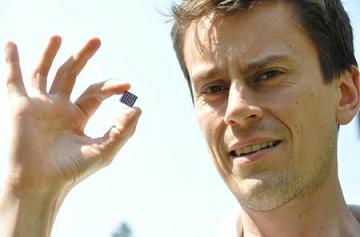Home > Press > Life of plastic solar cells jumps from hours to eight months
 |
| David Rider shows off an unsealed plastic solar cell |
Abstract:
A team of researchers from the University of Alberta and the National Institute for Nanotechnology has extended the operating life of an unsealed plastic solar cell from mere hours to eight months.
By Brian Murphy
Life of plastic solar cells jumps from hours to eight months
Edmonton | Posted on June 30th, 2010U of A chemistry researcher David Rider says plastic solar-cell technology is a very competitive field and the accomplishment by the U of A-NINT team is quite an achievement.
"Inexpensive, lightweight plastic solar-cell products, like a blanket or sheet that can be rolled up, will change the solar energy industry," said Rider.
The research team initially hit a wall trying to increase the operating life of their plastic solar-cell design. Rider says one of the problems involved electrodes, a key piece of the circuitry required for the efficient extraction of electricity from the solar cell.
"A typical electrode priming coating is known to be unstable and can migrate through the circuitry, potentially limiting the performance of our cell to about 10 hours," said Rider.
So the researchers came up with a new polymer coating that outlasted their original by more than 5,000 per cent: When Rider and team submitted their findings to a science journal, the new plastic solar cell had clocked 500 hours of high-capacity performance.
And Rider says that the solar cell might still be working at high capacity today, had it not been for damage caused during return shipping from additional testing in Ottawa. "Seven months after we handed in the research on the 500-hour breakthrough, the solar cell was still working," said Rider.
The research of Rider and his colleagues Jillian Buriak and Michael J. Brett was published this week in Advanced Functional Materials.
Rider says that, despite his team's success and advances made by research groups around the world, there's a lot of work to be done before plastic solar-cell kits are available at home-improvement stores across Canada.
"We have to increase their efficiency while maintaining a long-performance life," said Rider. "Getting eight months of high-capacity performance out of our design is moving in the right direction."
####
For more information, please click here
Copyright © University of Alberta
If you have a comment, please Contact us.Issuers of news releases, not 7th Wave, Inc. or Nanotechnology Now, are solely responsible for the accuracy of the content.
| Related News Press |
News and information
![]() Researchers develop molecular qubits that communicate at telecom frequencies October 3rd, 2025
Researchers develop molecular qubits that communicate at telecom frequencies October 3rd, 2025
![]() Next-generation quantum communication October 3rd, 2025
Next-generation quantum communication October 3rd, 2025
![]() "Nanoreactor" cage uses visible light for catalytic and ultra-selective cross-cycloadditions October 3rd, 2025
"Nanoreactor" cage uses visible light for catalytic and ultra-selective cross-cycloadditions October 3rd, 2025
Possible Futures
![]() Spinel-type sulfide semiconductors to operate the next-generation LEDs and solar cells For solar-cell absorbers and green-LED source October 3rd, 2025
Spinel-type sulfide semiconductors to operate the next-generation LEDs and solar cells For solar-cell absorbers and green-LED source October 3rd, 2025
Academic/Education
![]() Rice University launches Rice Synthetic Biology Institute to improve lives January 12th, 2024
Rice University launches Rice Synthetic Biology Institute to improve lives January 12th, 2024
![]() Multi-institution, $4.6 million NSF grant to fund nanotechnology training September 9th, 2022
Multi-institution, $4.6 million NSF grant to fund nanotechnology training September 9th, 2022
Announcements
![]() Rice membrane extracts lithium from brines with greater speed, less waste October 3rd, 2025
Rice membrane extracts lithium from brines with greater speed, less waste October 3rd, 2025
![]() Researchers develop molecular qubits that communicate at telecom frequencies October 3rd, 2025
Researchers develop molecular qubits that communicate at telecom frequencies October 3rd, 2025
![]() Next-generation quantum communication October 3rd, 2025
Next-generation quantum communication October 3rd, 2025
![]() "Nanoreactor" cage uses visible light for catalytic and ultra-selective cross-cycloadditions October 3rd, 2025
"Nanoreactor" cage uses visible light for catalytic and ultra-selective cross-cycloadditions October 3rd, 2025
Energy
![]() Sensors innovations for smart lithium-based batteries: advancements, opportunities, and potential challenges August 8th, 2025
Sensors innovations for smart lithium-based batteries: advancements, opportunities, and potential challenges August 8th, 2025
![]() Simple algorithm paired with standard imaging tool could predict failure in lithium metal batteries August 8th, 2025
Simple algorithm paired with standard imaging tool could predict failure in lithium metal batteries August 8th, 2025
Research partnerships
![]() Lab to industry: InSe wafer-scale breakthrough for future electronics August 8th, 2025
Lab to industry: InSe wafer-scale breakthrough for future electronics August 8th, 2025
![]() HKU physicists uncover hidden order in the quantum world through deconfined quantum critical points April 25th, 2025
HKU physicists uncover hidden order in the quantum world through deconfined quantum critical points April 25th, 2025
Solar/Photovoltaic
![]() Spinel-type sulfide semiconductors to operate the next-generation LEDs and solar cells For solar-cell absorbers and green-LED source October 3rd, 2025
Spinel-type sulfide semiconductors to operate the next-generation LEDs and solar cells For solar-cell absorbers and green-LED source October 3rd, 2025
![]() KAIST researchers introduce new and improved, next-generation perovskite solar cell November 8th, 2024
KAIST researchers introduce new and improved, next-generation perovskite solar cell November 8th, 2024
![]() Groundbreaking precision in single-molecule optoelectronics August 16th, 2024
Groundbreaking precision in single-molecule optoelectronics August 16th, 2024
![]() Development of zinc oxide nanopagoda array photoelectrode: photoelectrochemical water-splitting hydrogen production January 12th, 2024
Development of zinc oxide nanopagoda array photoelectrode: photoelectrochemical water-splitting hydrogen production January 12th, 2024
|
|
||
|
|
||
| The latest news from around the world, FREE | ||
|
|
||
|
|
||
| Premium Products | ||
|
|
||
|
Only the news you want to read!
Learn More |
||
|
|
||
|
Full-service, expert consulting
Learn More |
||
|
|
||








